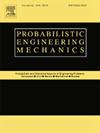完全考虑非平稳非高斯特性的随机地震动模拟及其在边坡可靠度评估中的应用
IF 3.5
3区 工程技术
Q2 ENGINEERING, MECHANICAL
引用次数: 0
摘要
对于进化非平稳过程,不能从自相关函数(ACF)中精确计算出进化功率谱密度(EPSD)。有效、准确地表征地震动的非高斯性和完全非平稳性是一个有待解决的难题,而边坡等强非线性结构在非平稳非高斯地震作用下的随机响应分析并不能提供清晰的信息。在统一Hermite多项式模型(UHPM)的基础上,提出了一种有效的非迭代高斯过程EPSD估计方法。该方法省去了迭代过程,避免了求解积分方程,提高了计算效率,并通过典型算例验证了该方法的准确性。引入适当的正交分解(POD)和快速傅立叶变换(FFT)技术,实现了完全非平稳和非高斯随机地震的高效、准确建模。以国会街路堑边坡为例,采用直接概率积分法(DPIM)对边坡进行随机动力稳定性评价。首次研究了地震的非高斯性和非平稳性对边坡动力稳定性的影响。分析表明,忽略地震的非高斯特征会导致地震边坡稳定性的低估,而非平稳特征则会降低地震边坡的稳定性。本文章由计算机程序翻译,如有差异,请以英文原文为准。
Stochastic ground motion simulation considering fully non-stationary non-Gaussian characteristics and its applications in slope reliability assessment
With respect to evolutionary non-stationary processes, the underlying evolutionary power spectral density (EPSD) cannot be accurately calculated from the autocorrelation function (ACF). Efficient and accurate characterization of the non-Gaussianity and fully non-stationarity of ground motions is a difficult problem to be solved, and the stochastic response analysis of strongly nonlinear structures such as slopes under non-stationary non-Gaussian earthquakes does not provide clarity. In this paper, an efficient non-iterative approach for estimating the EPSD of the underlying Gaussian process built upon the unified Hermite polynomial Model (UHPM) is proposed. The proposed method eliminates the need for iterative procedures and avoids the need to solve integral equations, thereby improving computational efficiency, and the accuracy is validated through a typical case study. Proper orthogonal decomposition (POD) and Fast Fourier Transform (FFT) techniques are introduced, and efficient and accurate modelling of fully non-stationary and non-Gaussian random earthquakes is achieved. The Congress Street cut slope is employed as a numerical illustration and the slope stochastic dynamic stability assessment is conducted via the direct probability integral method (DPIM). The impact of the non-Gaussianity and non-stationarity of earthquakes on slope dynamic stability is studied for the first time. The analysis indicates that neglecting the non-Gaussian characteristics of earthquakes can cause an undervaluation of seismic slope stability, whereas the non-stationary characteristics can reduce seismic slope stability.
求助全文
通过发布文献求助,成功后即可免费获取论文全文。
去求助
来源期刊

Probabilistic Engineering Mechanics
工程技术-工程:机械
CiteScore
3.80
自引率
15.40%
发文量
98
审稿时长
13.5 months
期刊介绍:
This journal provides a forum for scholarly work dealing primarily with probabilistic and statistical approaches to contemporary solid/structural and fluid mechanics problems encountered in diverse technical disciplines such as aerospace, civil, marine, mechanical, and nuclear engineering. The journal aims to maintain a healthy balance between general solution techniques and problem-specific results, encouraging a fruitful exchange of ideas among disparate engineering specialities.
 求助内容:
求助内容: 应助结果提醒方式:
应助结果提醒方式:


